
Meant for entertainment purposes only!
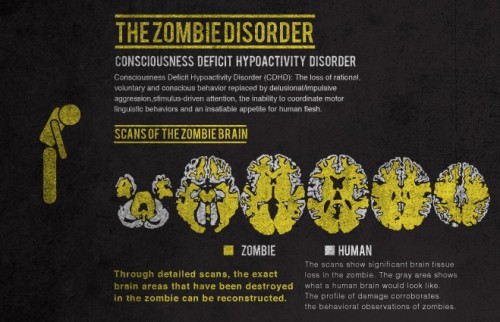
Understanding the zombie brain is paramount to the survival of man.
Below is an extensive interview with Bradley Voytek, Zombie neuroscience expert (seriously) and Zombie Research Society. They provide an explanation of zombie behavior due to abnormalities of the brain and suggestions on surviving against zombies.
Here’s an excerpt from this video interview:
In my research on necroneurology, my colleague Timothy Verstynen and I, in conjunction with the Zombie Research Society (http://www.zombieresearch.org/ad…), have identified several key features of zombie behavior.
This disorder, which we have dubbed “Consciousness Deficit Hypoactivity Disorder” (CDHD): is marked by the loss of rational, voluntary and conscious behavior replaced by delusional/impulsive aggression, stimulus-driven attention, and the inability to coordinate motor or linguistic behaviors.
Furthermore, in our detailed scans of the zombie brain, we have been able to reconstruct the exact brain areas that have been destroyed in the zombie. The profile of damage we have outlined corroborates the behavioral observations we have made.

In this above scans, you can clearly see the massive brain tissue loss in the zombie (orange) compared to the intact human brain (gray).
By closely examining zombie neurology and behavior, we can leverage our knowledge of the physical limitations and behavioral susceptibility of the zombie to our survival advantage.
First: find some leather.
Seriously.
Why people in zombie movies don’t wear leather neck guards and boots is beyond me. Put on a simple leather jacket with a high collar and some leather boots and you’ll prevent any surprise zombie bitings from behind or down low.
Practice safe zombieing!
Back to the science.
From a subjective standpoint, the pattern of cerebral atrophy in the zombie represents a most heinous form of injury unparalleled in the scientific literature. It would lead to a pattern of violence and social apathy; patients thus affected would represent a grievous harm to society, with little chance of rehabilitation.
The only recommendation is immediate quarantine and isolation of the subject. Based upon our observations, we are confident enough to offer a few strategies to maximize survival in the event of a zombie encounter:
1. Due to damage to the cerebellum, zombies exhibit severe ataxia and thus will be slow and uncoordinated. So outrun them. Climb to a high point or some other place where they will have trouble reaching. Practice parkour.
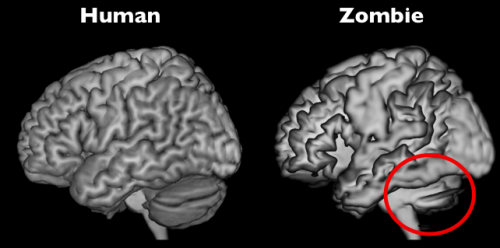
Notice the degenerated cerebellum!
Though be warned, as of now we have identified two distinct zombie phenotypes. The previously-mentioned ataxic class and a second, “fast” zombie.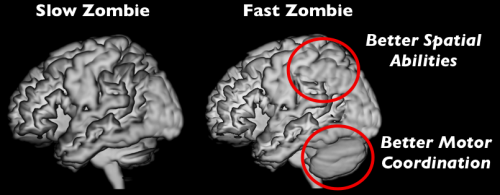
This second class has an intact cerebellum and superior parietal cortex, making them faster, more coordinated, and thus more dangerous.
Know your zombie types!
2. The zombie memory is terrible due to medial temporal lobe damage (think “Memento”). So, if you can hide long enough, the creature will mill around only until something else captures its attention. Be patient but keep quiet! They can still hear!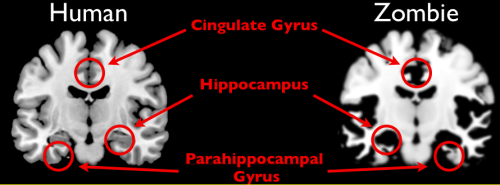
3. Due to damage to the parietal cortices, zombies can’t feel pain; if you can’t kill them by damaging the brainstem, don’t try to fight them. They won’t feel a thing. Your options are quick disposal or a hasty retreat.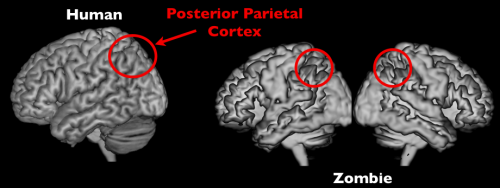
Fortunately, the extent of damage to the zombie parietal cortex, zombies also suffer from a form of Balint’s syndrome (http://en.wikipedia.org/wiki/Bal…), and thus are especially prone to lapses in attention. This leads us to survival point four:
4. Distraction, distraction, distraction. Throw something behind the zombie to capture its attention. Set off a flare. Use a flashbang. Whatever you need to do to distract it to get away.
Interestingly, zombies also appear to exhibit a form of the Capgras delusion (http://en.wikipedia.org/wiki/Cap…) such that when they do recognize you, their conception of you is no longer one of love or caring, but of confusion or even anger. This leads to tip five:
5. If the zombie’s ataxia isn’t enough to allow you to outrun it, you may wish to act like a zombie until you can escape. Mimicking in-group zombie behaviors may buy you critical moments!
Finally: although they may look like your loved ones, there is no reasoning with them. Their prefrontal cortex, as well as language production and comprehension areas, are so damaged that there is no possibility for communication. Do not fall prey to your own ignorance of the brain!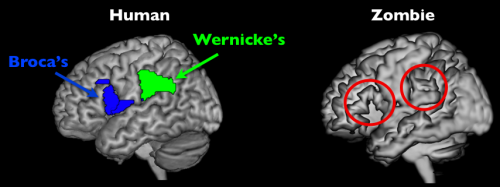
Source: J Briggs infograph & Dr Bradley Voytek








